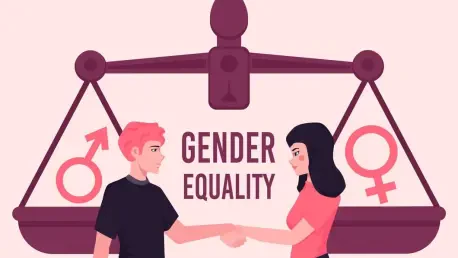Imagine a vibrant film industry where talent shines regardless of gender, yet beneath the glitz lies a stark reality of systemic discrimination that disproportionately affects women, especially those from marginalized backgrounds. In Kerala, a powerhouse of Indian cinema renowned for its storytelling and cultural depth, the struggle for gender parity has taken center stage. A recent directive from the Kerala High Court has spotlighted the urgent need for a transformative approach to equality laws, pushing for intersectionality to address the compounded challenges faced by diverse groups of women in the sector. This judicial intervention sets a compelling stage for exploring how legal frameworks can evolve to ensure true inclusivity in an industry that shapes societal narratives.
Overview of Gender Issues in the Film Industry
The film industry, while a beacon of creativity, remains a battleground for gender equality, with women often facing systemic barriers that hinder their progress. From unequal pay to limited access to leadership roles, the challenges are deep-rooted, often worsened by harassment and workplace biases that discourage participation. In Kerala, where cinema is a cultural cornerstone, these issues are particularly pronounced, as traditional gender norms frequently intersect with professional dynamics, creating a hostile environment for many.
Kerala’s entertainment sector holds immense significance, contributing to both economic growth and cultural identity through acclaimed productions and global recognition. Key players, including production houses and influential filmmakers, dominate the landscape, yet policies addressing gender disparities remain underdeveloped. While some mechanisms like internal complaints committees exist, their effectiveness is often questioned, highlighting a critical gap between intent and impact in fostering a safe, equitable space for women in the industry.
Understanding Intersectionality in Gender Equality
Defining Intersectionality and Its Relevance
Intersectionality, as underscored by the Kerala High Court, refers to the overlapping layers of identity—such as caste, economic status, and social background—that compound discrimination for women in the film industry. A woman from a lower caste or economically disadvantaged group, for instance, may face not only gender-based bias but also societal prejudices tied to her other identities, amplifying her vulnerability. This concept challenges the notion of treating women as a uniform group, revealing the need for tailored solutions.
A one-size-fits-all approach to gender equality often falls short because it overlooks these unique struggles. Policies that ignore intersectional factors risk leaving behind those who are most marginalized, perpetuating inequity under the guise of fairness. Recognizing these nuances is essential to crafting laws that protect all women, ensuring that no one is excluded due to the complexity of their lived experiences.
Judicial Perspective on Inclusive Legislation
During a recent hearing on the Justice Hema Committee report, a Special Bench of the Kerala High Court, comprising Dr. Justice AK Jayasankaran Nambiar and Justice CS Sudha, made oral observations emphasizing that equality laws must move beyond the simplistic male-female binary. The court argued for a legal framework that acknowledges diverse identities, ensuring protection for women across various social strata. This stance reflects a progressive understanding of gender justice in professional spaces.
The Bench’s call for nuanced legislation aims to address the specific ways in which overlapping forms of oppression impact individuals. By advocating for inclusivity in policy design, the court seeks to create a system where fairness is not just an ideal but a practical outcome, safeguarding even the most vulnerable within the industry. This judicial push signals a shift toward more comprehensive protections that resonate with real-world challenges.
Challenges in Addressing Gender Discrimination in Film
The film industry presents unique obstacles in combating gender-based discrimination, largely due to entrenched systemic biases that favor established norms. Women often encounter subtle and overt forms of exclusion, from being sidelined in decision-making to facing harassment with little recourse, as power imbalances dominate the sector. These issues are compounded by a culture that sometimes normalizes such behavior, making change a slow and arduous process.
Cultural barriers further complicate the fight against inequality, as societal expectations around gender roles often seep into professional settings. Many women hesitate to report misconduct due to fear of retaliation or stigma, which perpetuates a cycle of silence. Addressing these challenges requires not just legal reforms but also a shift in mindset across the industry to prioritize respect and accountability.
Existing laws, such as the Sexual Harassment of Women at Workplace (Prevention, Prohibition and Redressal) Act, 2013 (PoSH Act), reveal significant gaps when applied to the entertainment sector. The informal nature of film work, coupled with transient project-based teams, makes implementation difficult, often leaving complaints unaddressed. Tailoring solutions to fit the distinctive dynamics of this field remains a pressing concern for effective gender justice.
Legal and Policy Landscape for Gender Justice
The current regulatory framework for workplace equality in the film industry leans heavily on the PoSH Act, yet its limitations are evident, as noted by the Women’s Commission. The Act struggles to accommodate the non-traditional structures of film production, where hierarchies are fluid and accountability is often unclear. This inadequacy has sparked calls for specialized legislation that better aligns with the sector’s realities.
The Kerala government has taken steps to address these concerns, notably through the Kerala Film Policy Conclave held earlier this year, where stakeholders discussed potential reforms. Updates from these discussions were shared publicly for feedback, though transparency issues persist, as highlighted by the Women in Cinema Collective (WCC). Senior Advocate Gopal Sankarnarayanan, representing WCC, pointed out that only partial insights from the conclave were disclosed, raising questions about the inclusivity of the process.
The Kerala High Court has also played a proactive role, reviewing procedural updates and requesting draft policies for scrutiny to ensure they reflect diverse perspectives. Concerns over limited disclosure of detailed minutes from policy discussions underscore the need for greater openness. With further hearings scheduled for later this year, the judiciary continues to push for a balanced approach that prioritizes equitable outcomes in policy formulation.
Future Directions for Equality Legislation in Film
Incorporating intersectionality into equality laws holds the potential to revolutionize protections for women in the film industry, creating a framework that truly accounts for diverse experiences. Such legislation could set benchmarks for addressing compounded discrimination, ensuring that policies are responsive to the needs of marginalized groups. This shift might inspire similar reforms in other sectors, amplifying the impact of Kerala’s initiative.
Emerging advocacy trends, alongside judicial precedents, suggest a growing momentum toward inclusive policies that challenge outdated norms. Societal shifts, including increased awareness of gender issues, are likely to influence future legislation, pushing for reforms that resonate with contemporary values. Collaboration among stakeholders—government, industry leaders, and advocacy groups—will be crucial in translating these aspirations into actionable laws over the coming years.
The path forward also involves learning from global best practices while adapting them to local contexts. By fostering dialogue and ensuring that policy drafts are informed by comprehensive input, there is an opportunity to build a robust system of protections. The ongoing engagement between the judiciary and other entities signals a promising trajectory for meaningful change in how equality is defined and enforced within the industry.
Conclusion and Recommendations for Inclusive Policies
Looking back, the Kerala High Court’s advocacy for intersectionality marked a defining moment in the journey toward gender justice in the film industry. The court’s insistence on recognizing the multifaceted identities of women paved the way for a deeper conversation about fairness and protection in a sector long plagued by inequality. This judicial stance, coupled with stakeholder efforts, illuminated the gaps in existing frameworks and the urgent need for reform.
Moving forward, policymakers should prioritize transparency by ensuring that all discussions and draft policies are fully accessible to the public, fostering trust in the process. Engaging a wide range of voices, especially from marginalized communities, must be central to crafting legislation that leaves no one behind. A dedicated task force could be established to monitor implementation and address industry-specific challenges over the next few years.
Additionally, training programs for industry professionals on intersectional issues could complement legal reforms, building a culture of respect and awareness. Regular reviews of policy effectiveness, guided by data and feedback, would help refine approaches to meet evolving needs. By embracing these steps, Kerala’s film industry could emerge as a model of inclusivity, setting a standard for others to follow in the pursuit of true equality.









